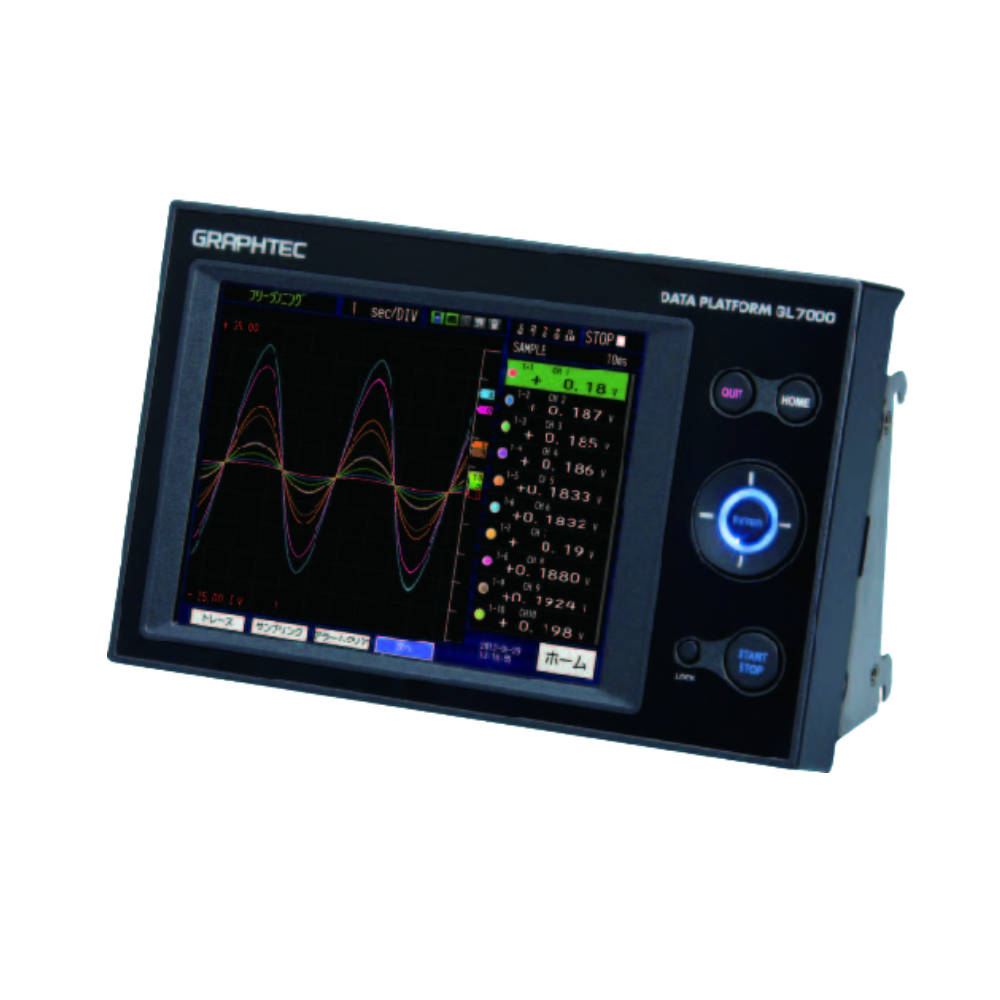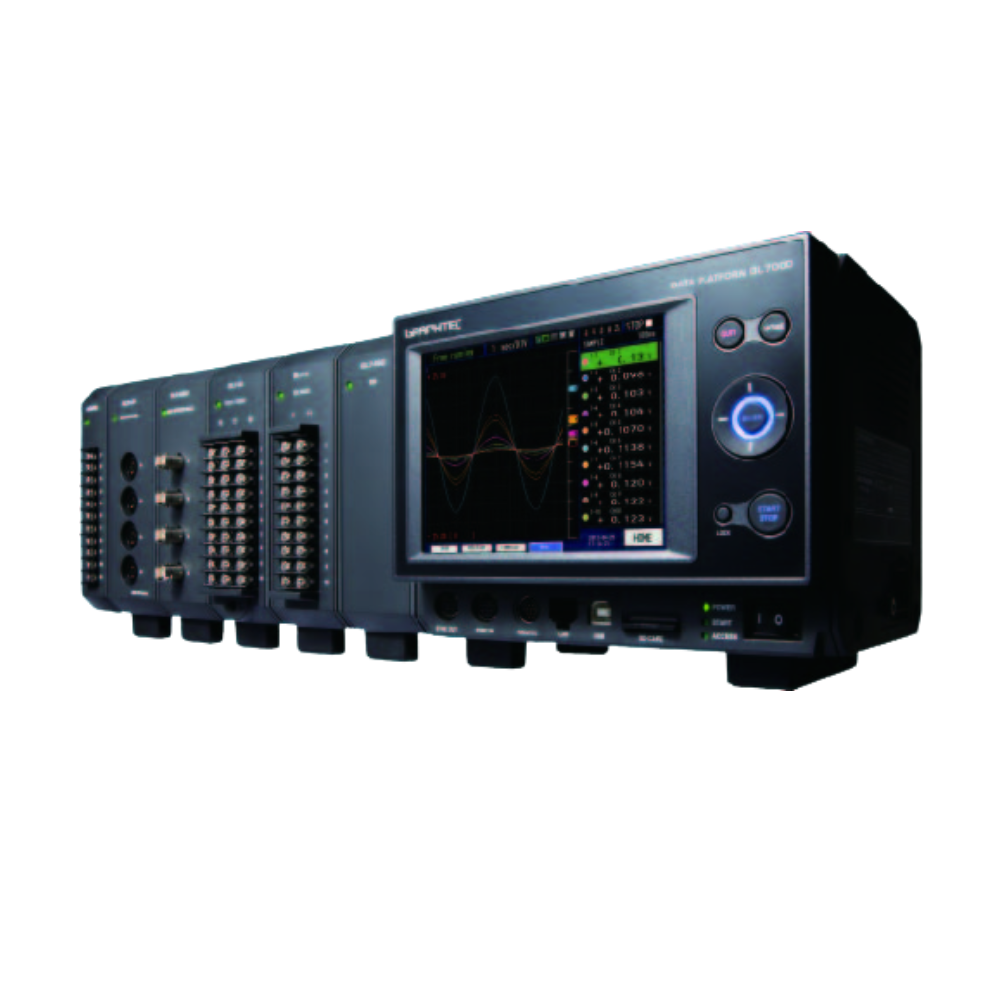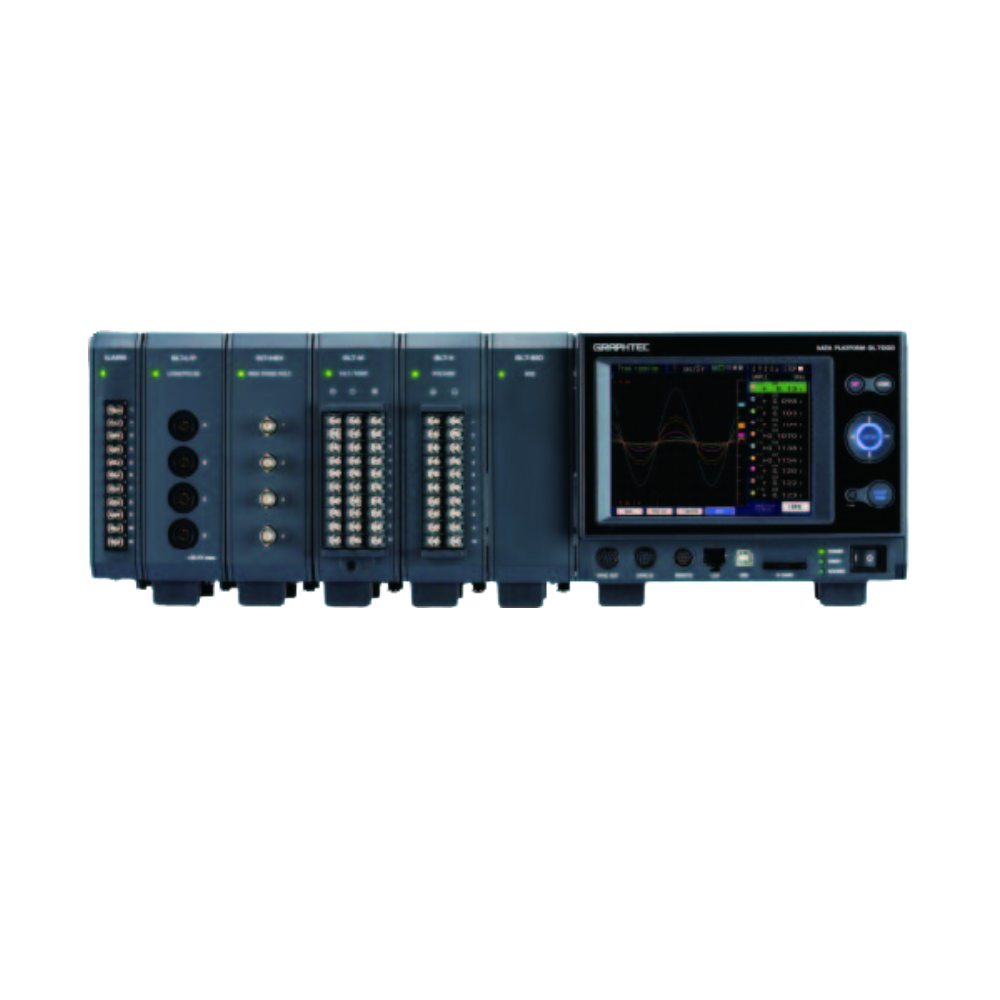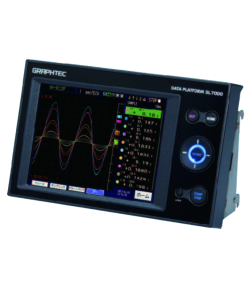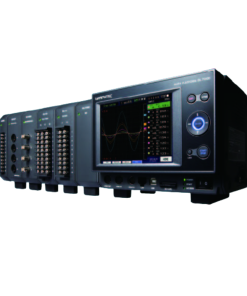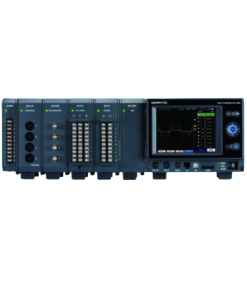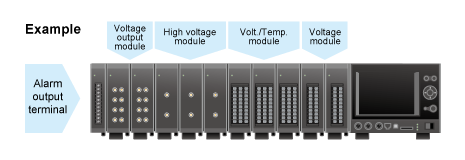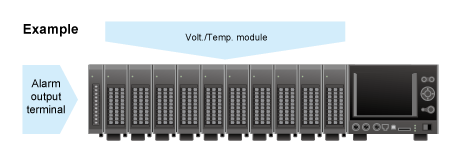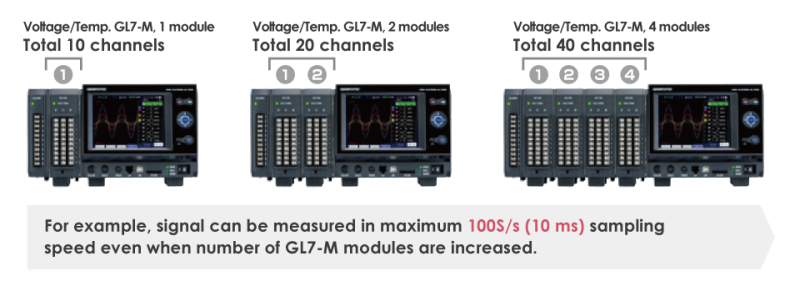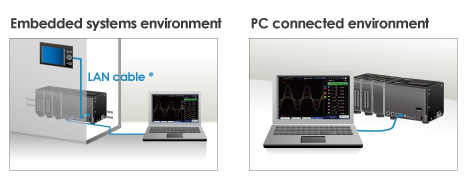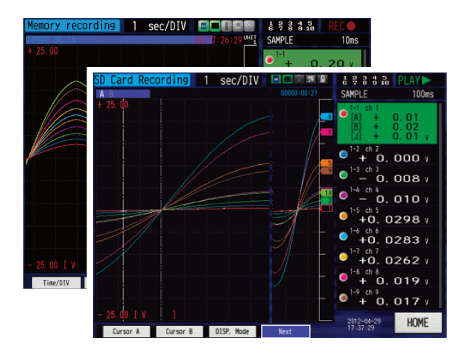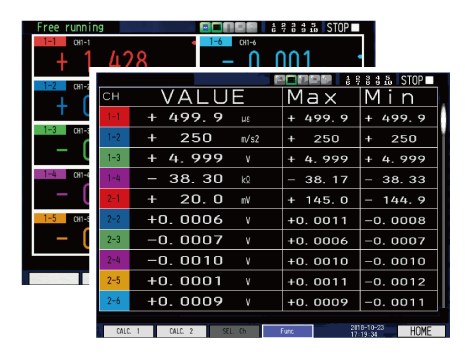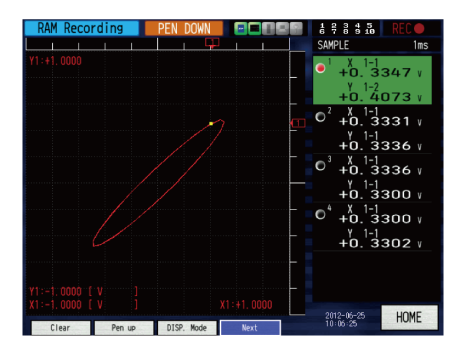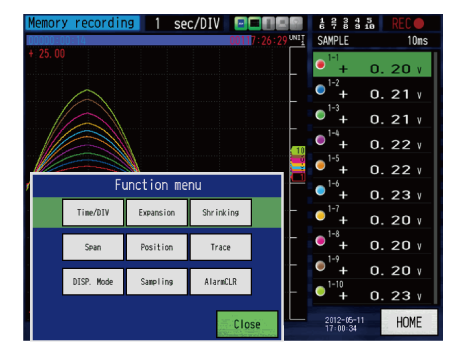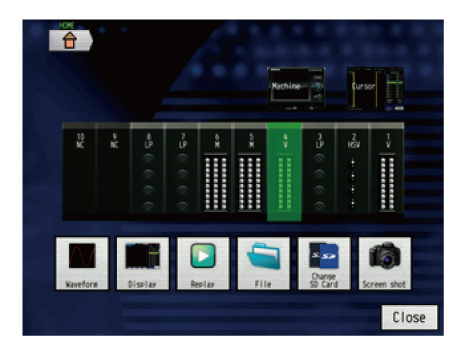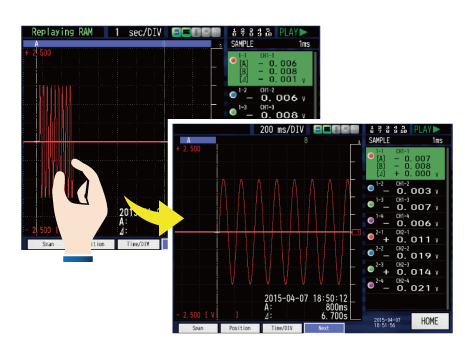| Item | Description | |
|---|---|---|
| Model number | GL7000 | |
| Number of module | Attached to up to 10 modules (*1) | |
| Number of input channels | Max. 112 channels in 1 of GL7000 | |
| External Input/Output signals (*2) | Input | Start/Stop, External trigger, External sampling, Auto balance (*3) Signal type: Contact (relay), Open collector, Voltage |
| Output | Trigger, Busy (*3), Alarm (10 channels) (*4) Signal type: Open collector (pulled-up by resistor 10 kΩ) |
|
| Trigger, Alarm function | Trigger action | Start or stop capturing data by the trigger |
| Trigger repeat | Enabled (ON): Automatically re-armed for the next data capture function Disabled (OFF): Data capture is completed in a single trigger (Hold off repeat action in specified period: Previous start to next start, previous stop to next start) |
|
| Trigger source | Start: Off, Measured signal, Alarm, External signal, Clock, Week or Time Stop: Off, Measured signal, Alarm, External signal, Clock, Week or Time |
|
| Trigger determination conditions for measured signal | Combination: OR or AND condition at the level of signal or edge of signal Analog: Higher/Rising, Lower/Falling, Window-in, Window-out Logic (*5): Higher/Rising, Lower/Falling Pulse (*5): Higher/Rising, Lower/Falling, Window-in, Window-out |
|
| Alarm determination condition (*6) | Combination: OR or AND condition at the level of signal or edge of signal Analog: Higher/Rising, Lower/Falling, Window-in, Window-out Logic (*5): Higher/Rising, Lower/Falling Pulse (*5): Higher/Rising, Lower/Falling, Window-in, Window-out |
|
| Alarm output | 10 channels | |
| Pre-trigger (*7) | Number of data before trigger: Up to specified number of captured data | |
| Calculation function | Between channels | Addition, Subtraction, Multiplication and Division for two analog inputs (Sampling speed is limited up to 10 Samples/s (100 ms interval). Available arithmetic element and the output destination is the analog input channel 1 to 100.) |
| Statistical | Select two calculations from Average, Peak, Max., Min. in real time and replay (*8) | |
| Move function of the display range | Beginning, center or end of the data, Trigger point, Specific time (absolute, relative), Call cursor | |
| Search function | Search for analog signal levels, logic signal pattern, pulse signal levels or alarm point in captured data | |
| Annotation function | Comment can be set in each channel (up to 31 alphanumeric characters) | |
| Message / Marker Functions | Message: The registered messages or entered message is able to be recorded for any timing. Up to 8 messages can be pre-registered. Marker: Marker is able to record for occurring alarm or power failure. |
|
| Resume | Resume automatically in the same condition after power is recovered as when the power failure occurred during data capture. (*9) | |
| FFT analysis function (Firmware ver. 1.20 or later) |
Analyzing frequency range | 0.08, 0.2, 0.4, 0.8, 1.6, 2, 3.2, 4, 8, 20, 40, 80, 200, 400, 800 Hz, 2, 4, 8, 20, 40, 80, 200, 400 kHz |
| Number of points | 500, 1000, 2000, 4000, 10000 | |
| Window function | Rectangular, Hanning, Hamming, Blackman, Flat-top, Exponential | |
| Averaging | Summation average, Exponential average, Peak hold | |
| Channels | 4 channels | |
| Functions | Y-T, Linear, Power, PSD, Cross, Transfer function, Coherence, COP | |
| Display mode | Single display, Dual display, Nyquist | |
| Interface to PC | Ethernet (10 BASE-T/100 BASE-TX), USB 2.0 (High speed) | |
| Network function | WEB server, FTP server, FTP client, NTP client, DHCP client | |
| USB drive mode | Emulate the USB memory device (*10) | |
| Storage device | Built-in | RAM (2 million samples, built-in amplifier module), Flash memory (4 GB, built-in the main module) (*12) |
| External (*11) | SD card (Support SDHC, up to 32GB) slot, SSD (Approx. 128GB (*12)) The file for capturing data is limited up to 4GB. (*13) |
|
| Data saving function | Sampling speed (interval) | 1 MS/S(1 million samples per second) to 1S/h (1 sample per hour), and synchronized with external sampling signal (Interval: 1, 2, 5, 10, 20, 50, 100, 200, 500 µs, 1, 2, 5, 10, 20, 50, 100, 200, 500 ms, 1, 2, 5, 10, 20, 30, 1, 2, 5, 10, 20, 30 min, 1 hur) * The maximum sapling speed (minimum sampling interval) is different depending on the type of module. * Sampling can be set up to the fastest speed among multiple type connected modules. If the set sampling speed exceeds the fastest speed on module, signal will be sampled and updated at the highest speed of its module and the previous data will be used until the data is updated. * The maximum sampling speed (minimum sampling interval) varies depending on the specified recording destination. |
| Built-in RAM: up to 1 MS/s (1 µs interval) | ||
| SSD module: up to 500 kS/s (2 µs interval) at 1 or 2 modules installed, up to 200 kS/s (5 µs interval) at 3 or 4 modules installed, up to 1 kS/s (1 ms interval) at 5 or 10 modules installed | ||
| Built-in Flash memory: up to 1 MS/s (1 µs interval) | ||
| External SD Flash memory: up to 1 kS/s (1 ms interval) | ||
| Captured data (*11) | Built-in RAM, Built-in Flash, SD memory card, SSD (Data is saved directly to it.) | |
| Data in built-in RAM | Specified number of data up 2 million samples in increments of 1 | |
| Auto save (*11) | Available for the built-in RAM Enabled (ON): Data in the RAM is saved automatically to the built-in Flash, SD memory card, SSD Disabled (OFF): Data in the RAM is not maintained after power is turned off |
|
| Capturing mode (*11) | Mode: Off, Normal, Ring, Relay Ring (*14): Saved most recent data (Number of capturing data: 1000 to 2000000 points, Destination of data: Built-in RAM, Built-in Flash, SD memory card, SSD) Relay(*13)(*15): Saved data to multiple file without losing data until capturing data is stopped (Destination of data: Built-in Flash, SD memory card, SSD) |
|
| During data capture (*17) | Displaying information in two windows, Hot-swapping the SD memory card, Saving data in between cursors. | |
| Backup (*11) | Backup interval (*18): Off, 1, 2, 6, 12, 24 hrs. Data destination (*18): SD memory card, SSD, FTP server Data format (*18): GBD (binary) or CSV (test) Data destination for backup cannot be specified to the same storage for destination of capturing data. |
|
| Dual sampling function (*19) | It enables to record signal with two sampling speed. While the signal is recorded with low speed sampling for long term recording, the transient part is recorded with high speed sampling after the trigger occurs. | |
| Current (low-speed) sampling Recording media:Built-in flash memory or SD card Sampling interval:1, 2, 5, 10, 20, 50, 100, 125, 200, 250, 500ms, 1, 2, 5, 10, 20, 30s, 1, 2, 5, 10, 20, 30min, 1h Trigger timer feature: Starting time, Stopping time, Repeat recording |
||
| Event (high-speed) sampling Recording media:Built-in RAM or SSD (optional) Sampling interval: 1, 2, 5, 10, 20, 50, 100, 200, 500us |
||
| Engineering Scale function | Measured value can be converted to the engineering unit Analog voltage: Converts by four reference points (gain, offset) Temperature: Converts by two reference points (offset) Pulse count: Converts by two reference points (gain) |
|
| Synchronization between units | Start and Trigger (*16) | |
| Accuracy of clock (at 23°C) | ±0.002% (Monthly deviation approx. 50 sec.) | |
| Operating environment | 0 to 40°C, 5 to 85% RH (non condensed) | |
| Power source | 100 to 240 V AC, 50 to 60Hz | |
| Power consumption | 110VA | |
| Standard accessories | Quick guide, CD-ROM, AC power cable | |
| External dimensions (W x D x H) | Main module: Approx. 193 x 141 x 160 mm (Excluding Projection), Alarm output terminal: Approx. 30 x 136 x 145 mm (Excluding projection) |
|
| Weight | Main module: Approx. 2.2 kg, Alarm output terminal: Approx. 350 g | |
(*1)Excluding the function module as the Display module or SSD module. In case of the DC Strain module (GL7-DCB): up to 8 modules. In case of the Logic/Pulse module (GL7-L/P): input mode is selected in the logic or pulse for each module, up to 7 modules when the module is used in the logic mode, up to 2 modules when the module is used in the pulse mode.
(*2)The Input/Output cable (B-513) is required for connecting the signal. The Auto balance signal input and the Busy signal output are available in the DC Strain module (GL7-DCB).
(*3)It is available on the DC strain (GL7DCB) module.
(*4)The alarm signals are outputted on the terminal block attached to the main module as standard accessory.
(*5)It is available on the Logic/Pulse (GL7-L/P) module.
(*6)Method of detection
Volt./Temp. module:
The alarm is detected every 5 seconds when the sampling interval is longer than 5 seconds and reported. The alarm is detected in the sampling interval when the sampling interval is shorter than 5 seconds and reported.
Other modules:
The alarm is detected every 1 ms when the sampling interval is shorter than 1ms. The alarm is detected in the sampling interval when the sampling interval is set between 2 ms to 5 seconds and reported. The alarm is detected every 5 seconds when the sampling interval is longer than 5 seconds and reported.(*7)It is available when the captured data is saved to the built-in RAM. The pre-trigger function may not available in combination with the trigger settings.
(*8)The result of real time calculation is displayed in the digital display mode. Available sampling speed is the 10 samples/s (100 ms interval).
(*9)When the captured data destination is set to the built-in-RAM, the captured data is not maintained after a power failure is occurred. When destination is set to the built-in Flash or the SD memory card, it may have a problem by a power failure if it is being accessed to write data. If the memory device is not damaged, the closed data file is maintained. The file is closed every minute while data is being captured. This function is not available when the FFT mode or the Voltage Output module (GL7-DCO) is used.
(*10)The USB drive mode is started by setting of the switch on the main module. It can be also started when the power is turned on while pressing the START/STOP key on the display module.
(*11)The SD memory card is not included as a standard accessory. Compatible SD card type: SD, SDHC Speed class 4 or faster. The SSD module (GL7-SSD) is an option.
(*12)Capacity of memory device may be smaller depending on time of production.
(*13)The file for recording data is limited up to 4GB on firmware version 2.0 or later, 2GB on firmware version 1.6 or before.
(*14)The capacity for saving the data is set to one third of available memory when the captured data destination is set to a device other than the built-in-RAM. Available sampling speed is up to 10 samples/s (100ms interval).
(*15)When the captured data destination is set to the built-in Flash or the SD memory card, sampling speed is limited up to 100 samples/s (10 ms interval). In case of using the SSD module (GL7-SSD), sampling speed in limited up to 50 thousand samples/s (20 µs interval) when 1 or 2 modules are attached.
(*16)The Sync cable (B-559) is required when this function is used. The GL-Connection software is required when the synchronizing function is used.
(*17)This function is able to be available when sampling speed is set up to 10 samples/s (100 ms interval).
(*18)The CSV format is available with firmware version 2.10 or rater.
– When the RING mode or external pulse synchronization sampling is selected for recording, the backup function is not available.
– When there are meany number of active channels, the sampling time is fast, or the backup interval is long, it may take time to closing the data file after recording stops because the size of the data to be backed up becomes large.
– Available sampling speed is the 10 ms or slower when using the CSV format.
– When backup is enabled and data file format is specified with CSV format, SD memory card exchange (hot-swapping) and RELAY recording are not available.(*19)Both slow and high speed sampling can only be recorded in GBD format.
When event (high-speed) capturing destination is extended SSD unit, it takes a few seconds for event capturing.
Following actions are not available:
– External sampling
– Ring / Relay recording
– Back up feature
– Dual screen feature (playback while recording)
– XY / FFT function
– Synchronization operating with multiple GL7000
– Configuring with only Voltage module (GL7-V) or Voltage/Temperature module (GL7-M)

